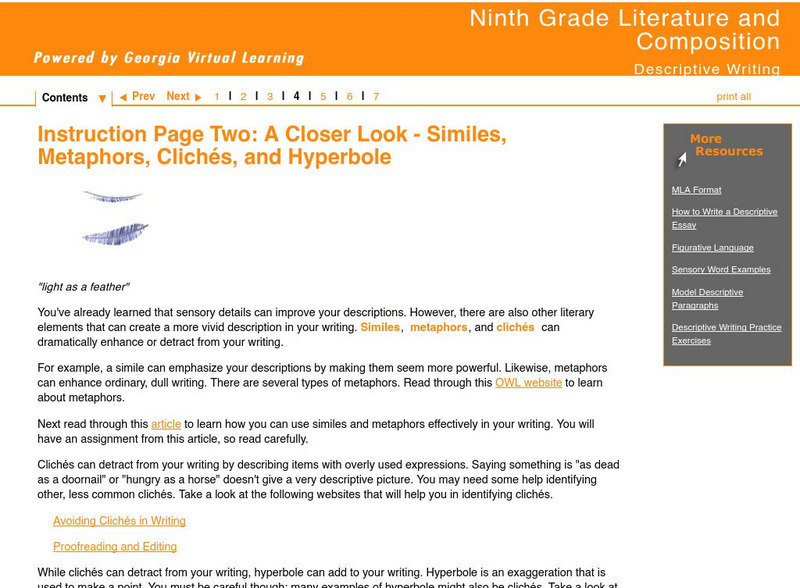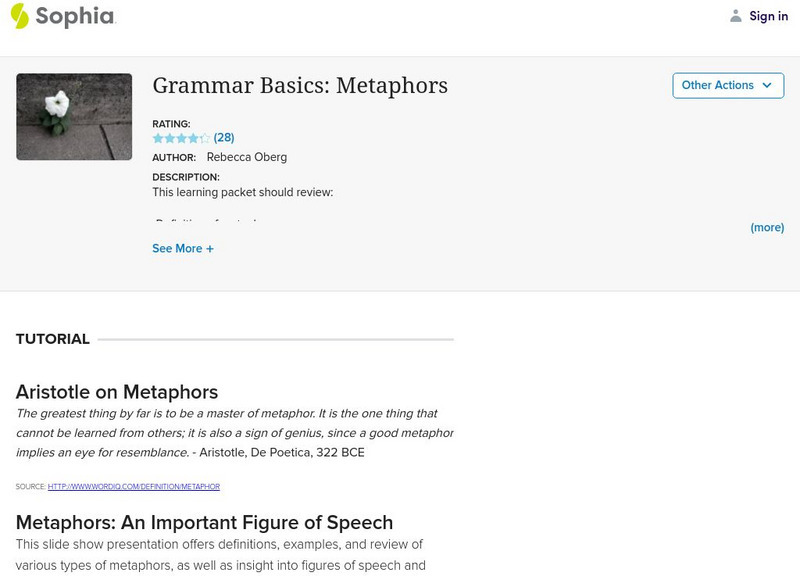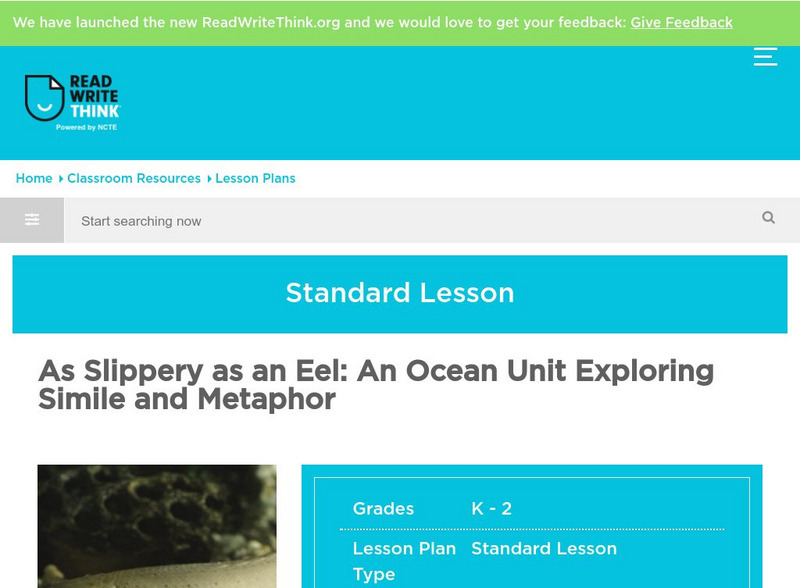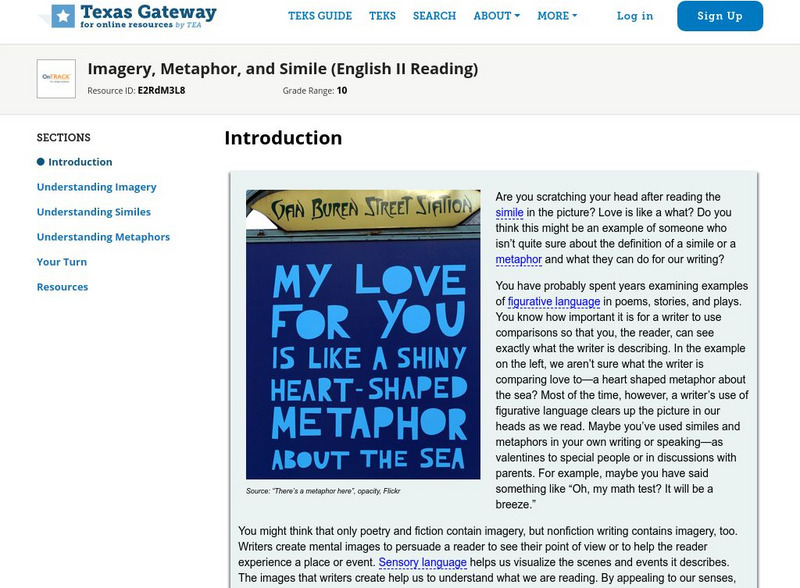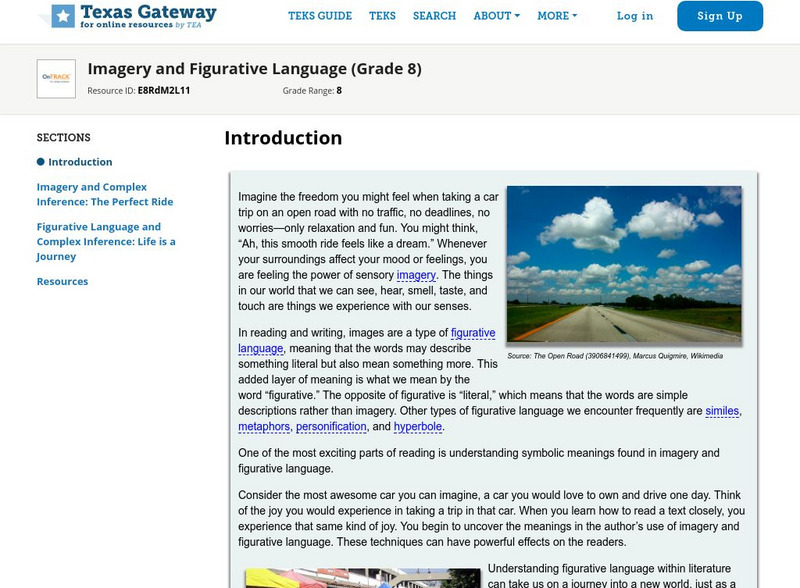Quia
Quia: Bud, Not Buddy: Similies and Metaphors
These games use the similes and metaphors from the novel Bud, Not Buddy. There are three games: Flashcards, Matching, and Concentration. Flashcards has half of the simile/metaphor on each side of the card; Matching has students match the...
Georgia Department of Education
Ga Virtual Learning: Descriptive Writing: Similes, Metaphors, Cliches, Hyperbole
This lesson focuses on figurative language used in descriptive writing including similes, metaphors, cliches, hyperbole. It offers multiple links to websites pertaining to figurative language in descriptive and creative writing; an...
Read Works
Read Works: 4th Grade Lesson: Similes and Metaphors
[Free Registration/Login Required] A lesson in which students use the book Poetry for Young People: Langston Hughes edited by David Roessel and Arnold Rampersad to learn to identify and understand the use of simile and metaphor in...
Sophia Learning
Sophia: Grammar Basics: Metaphors
This tutorial focuses on metaphors using a PowerPoint presentation which offers definitions, examples, and various types of metaphors, as well as, similes for comparison. It provides two YouTube videos: the first includes popular songs...
McGraw Hill
Mc Graw Hill: Vocabulary Acquisition and Use: Understand Figurative Language
Explains what similes and metaphors are and how they are alike and different. Provides examples and practice sheets for each.
Sophia Learning
Sophia: Grammar Basics: Metaphors
Learn about similes and metaphors through this multimedia presentation. First view a slide show describing different types of metaphors as well as a simile. Then watch a video [3:13] showing similes and metaphors used in popular songs. A...
TES Global
Tes: Teaching Shakespeare: Sonnet 130 Year 7
[Free Registration/Login Required] This lesson plan for Shakespeare's "Sonnet 130" asks students to mark the rhyme scheme and highlight similes and metaphors, to respond to a modern letter with a message similar to the sonnet, and to...
ReadWriteThink
Read Write Think: An Ocean Unit Exploring Simile and Metaphor
Contains plans for four lessons that teach students about similes and metaphors using ocean themed resources. In addition to objectives and standards, this instructional plan contains links to sites used in the lessons as well as...
Alabama Learning Exchange
Alex: Figurative Language
This lesson used a slideshow presentation to explain the difference between similes and metaphors. Students are challenged to identify these figurative elements in literature and then create some themselves.
Texas Education Agency
Texas Gateway: Literary Text: Imagery, Metaphor, and Simile
Writers use sensory imagery ("smelled the salty air"), similes ("like a strong man playing tug-of-war"), and metaphors ("the waves roaring in my ears") to capture the reader's imagination. In this lesson, you will learn how to identify...
Read Works
Read Works: 3rd Grade Lesson: Poetry
[Free Registration/Login Required] A lesson plan in which students use two provided poems to learn to identify and understand the use of similes and metaphors in poetry. Lesson includes direct teaching, guided practice, and independent...
ReadWriteThink
Read Write Think: Figurative Language Awards Ceremony
Contains plans for five to seven lessons that teach about figurative language like similes, metaphors, and personification by asking students to write award acceptance speeches that incorporate them. In addition to objectives and...
PBS
Pbs Learning Media: Literary Elements and Techniques: Figurative Language
Discover how authors use figurative language to enhance their writing and explore the differences between similes and metaphors in this animated video [3:37] from WNET. Discussion questions below help students to further apply their...
Love To Know Media
Your Dictionary: Literary Terms Lesson Plan
This is a lesson plan for teaching the seven literary terms used in poetry: simile, metaphor, alliteration, imagery, hyperbole, personification, and onomatopoeia.
ClassFlow
Class Flow: Metaphor & Simile
[Free Registration/Login Required] This flipchart helps students understand the use of metaphors and similes in written and spoken language. There are several fun examples, activities and whole group feedback using Activotes.
Texas Education Agency
Texas Gateway: Imagery and Figurative Language (Grade 8)
In this lesson, students learn how to make complex inferences and use textual evidence such as imagery and figurative language to support understanding.
ClassFlow
Class Flow: Figurative Language
[Free Registration/Login Required] This resource explores figurative language including similes, metaphors, and personification. There are many activities used to support the exploration of each type of figurative language.
ClassFlow
Class Flow: Analyzing Poetry
[Free Registration/Login Required] Students use poetic devices to analyze a poem of their choice from the Library of Congress.



